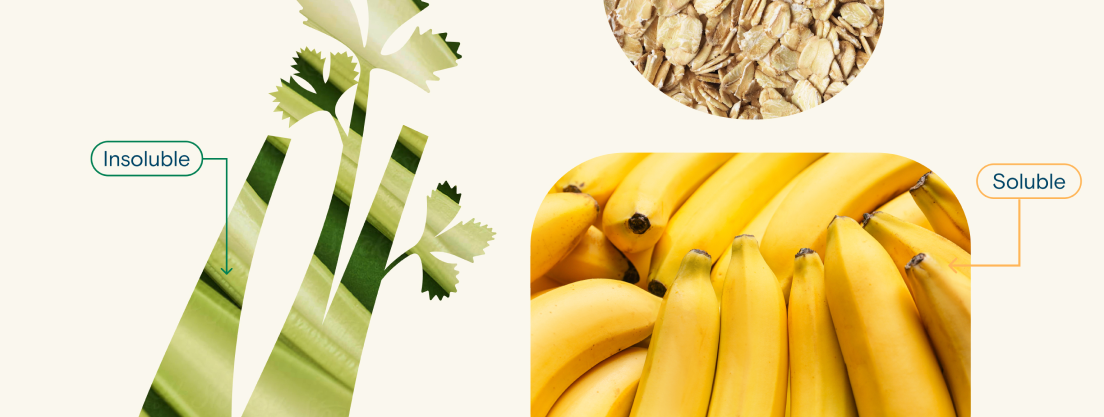Understanding Soluble and Insoluble Fiber


Did you know that there are different classifications of fiber that you consume through your diet? Some fiber is soluble, while others are insoluble. On top of that, fiber has different levels of fermentability and viscosity. But before we dive in, let’s do a quick recap of the basics.
We’ve already discussed what fiber is, why it’s so important, and plant foods you can incorporate into your diet to get more of it. Now we’re onto next-level fiber education — because the more you know, the more equipped you are to provide quality nutrition for yourself and your loved ones!
Soluble vs. insoluble fiber
On nutrition labels, fiber may be classified as “soluble” or “insoluble.” Soluble fiber absorbs water, while insoluble fiber does not absorb water or break down.
When we eat foods with soluble fiber, it turns into a gel-like substance that helps food move down the digestive tract. Soluble fiber can act like a sponge that helps absorb and remove some nutrients, like cholesterol and fat, carrying them out of your body in your waste.
Since insoluble fiber does not absorb water, it instead adds bulk to your stool and moves your food through your intestines.
Both insoluble and soluble fiber help keep your digestive tract functioning properly,1and many foods contain both insoluble and soluble fiber, in varying amounts.
Goo vs. grit
Fiber provides a texture to plant foods. A fun way for you to distinguish soluble from insoluble fiber is to examine the food’s “goo and grit.”
Sometimes fiber in foods can be gooey, think a ripe papaya, plum, peach, fig, or gooey oatmeal.
Other times fiber in foods can be on the gritty side. Think of the string in celery you can pull apart, the crunch of a carrot when you snap it or bite into it. Even the gritty part of whole grain bread.
Try this exercise for yourself: Do you think that a banana would include more soluble or insoluble fiber? What about turnips?
Bananas contain around 3 grams of fiber per banana,2 most of which is soluble. (Fun fact: studies have shown that the ripeness of a banana can affect the amount of fiber found in the banana!3) One half cup of turnips contains about 4.8 grams of fiber,4 the majority of which is insoluble fiber. Did you guess correctly?
Gut fermentation and fiber
Fiber is categorized on food labels as soluble or insoluble, but solubility is just one characteristic of fiber. There are other factors, such as fermentability, that impact the function and effect of fiber.6
Our gut fermentation is the process of gut bacteria digesting fiber. The microorganisms eat the fiber we provide them, and as a result, this creates a happy environment in your gut that allows for more good bacteria to be present.7
We are never truly alone … and that’s because each one of us carries around trillions of microorganisms on our skin, in our mouths, and in our digestive system at all times. But don’t fear — not all bacteria are bad! In fact, the gut microbiome (the fungi, viruses, and bacteria in your gut) help support your immune system and your digestive system.
A quick summary before you go:
Soluble fiber tends to be found in “gooier” plant foods and can absorb water. It forms a gel-like substance, slows digestion, and allows for nutrients to be absorbed.
Insoluble fiber tends to be found in “grittier” plant foods and cannot absorb water. It adds bulk to your stool and helps get food moving through your digestive system.
Fiber feeds the bacteria in our gut, a process called fermentation, which help our digestive and immune systems function properly.
Bestsellers
Discover More
Learn more about our specialized products, read digestible articles, find community, and so much more.
Disclaimer, this is not medical advice. Please consult your healthcare professional for medical advice.
References:
McRorie Jr, McKeown. Understanding the physics of functional fibers in the gastrointestinal tract: an evidence-based approach to resolving enduring misconceptions about insoluble and soluble fiber. Pub Med. Epub 2016.
Harvard T.H. Chain, School of Public Health. The Nutrition Source. Bananas.
Phillips, K. M., McGinty, R. C., Couture, G., Pehrsson, P. R., McKillop, K., & Fukagawa, N. K. (2021). Dietary fiber, starch, and sugars in bananas at different stages of ripeness in the retail market. Plos one, 16(7), e0253366.
National Library of Medicine. Lifestyle Changes: Effect of Diet, Exercise, Functional Food, and Obesity Treatment on Lipids and Lipoproteins. Table 8: Fiber Content of Selected Vegetables. 2020-2023.
Williams, Mikkelsen, Flanagan, Gidley. “Dietary fibre”: moving beyond the “soluble/insoluble” classification for monogastric nutrition, with an emphasis on humans and pigs. J Anim Sci Biotechnol. Published May 24, 2019.
Oliphant K et al. Macronutrient metabolism by the human gut microbiome: Major fermentation by-products and their impact on host health. Microbiome 2019; 7:91.








